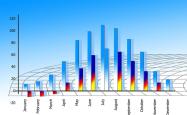足球数据分析软件哪个好用
Football Data Analysis Model
Introduction:
Football data analysis models are essential tools for extracting meaningful insights from vast amounts of football data. These models use statistical techniques, machine learning algorithms, and data visualization to analyze various aspects of the game, including player performance, team tactics, and match outcomes. This article will provide an overview of a football data analysis model in English.
Building the Model:
1. Data Collection: The first step in building a football data analysis model is to gather relevant data. This could include data such as player statistics, match results, team formations, and inmatch events. The data can be collected from various sources, including online databases, official football websites, and APIs.
2. Data Cleaning and Preprocessing: Once the data is collected, it is essential to clean and preprocess it to ensure the accuracy and consistency of the data. Data cleaning may involve removing duplicates, handling missing values, and transforming the data into a suitable format for analysis.

3. Feature Engineering: Feature engineering involves selecting or creating relevant features from the available data to represent different aspects of the game. For example, features such as goals scored, assists, and pass completion rate can be created for individual players. Similarly, features like possession percentage, shots on target, and goals conceded can be created for teams.
4. Model Selection: There are various statistical and machine learning models available for football data analysis. The choice of model depends on the specific problem and the nature of the data. Some commonly used models include regression models, decision trees, random forests, and neural networks.
5. Model Training and Evaluation: After selecting the model, the next step is to train it using the prepared dataset. The dataset is divided into training and testing sets, and the model is trained on the training set. The trained model is then evaluated using the testing set to determine its performance and make any necessary adjustments.
6. Insights and Visualization: Once the model is trained and evaluated, it can be used to extract insights from the data. These insights can help understand player performance, team dynamics, and identify key factors that influence match outcomes. Data visualization techniques, such as plots, graphs, and heatmaps, can be used to present the findings in a more accessible and intuitive manner.
Benefits and Applications:
1. Performance Analysis: Football data analysis models can be used to assess player performance based on various metrics such as goals, assists, successful passes, or defensive actions. This information can be beneficial for player recruitment, contract negotiations, and tactical decisionmaking.
2. Team Tactics: By analyzing team statistics, such as possession, shots on target, or successful passes, coaches and analysts can gain insights into team tactics. This can help in devising game strategies, identifying areas for improvement, and assessing the effectiveness of different formations.
3. Match Prediction: Football data analysis models can also be utilized for match outcome prediction. By considering various factors such as team form, player availability, and historical performance, these models can provide predictions on the likelihood of certain outcomes, such as win, draw, or loss.
4. Player Development: Football clubs can use data analysis models to identify young talents based on their performance data. By analyzing player characteristics and historical performance, clubs can make informed decisions on player development, training programs, and scouting strategies.
Conclusion:
Football data analysis models have revolutionized the way the game is analyzed and understood. By using these models, teams, coaches, and analysts can gain valuable insights into player performance, team tactics, and match outcomes. The continuous advancements in data analytics and machine learning techniques will further enhance the capabilities of these models, leading to better decisionmaking and improved performance on and off the field.








